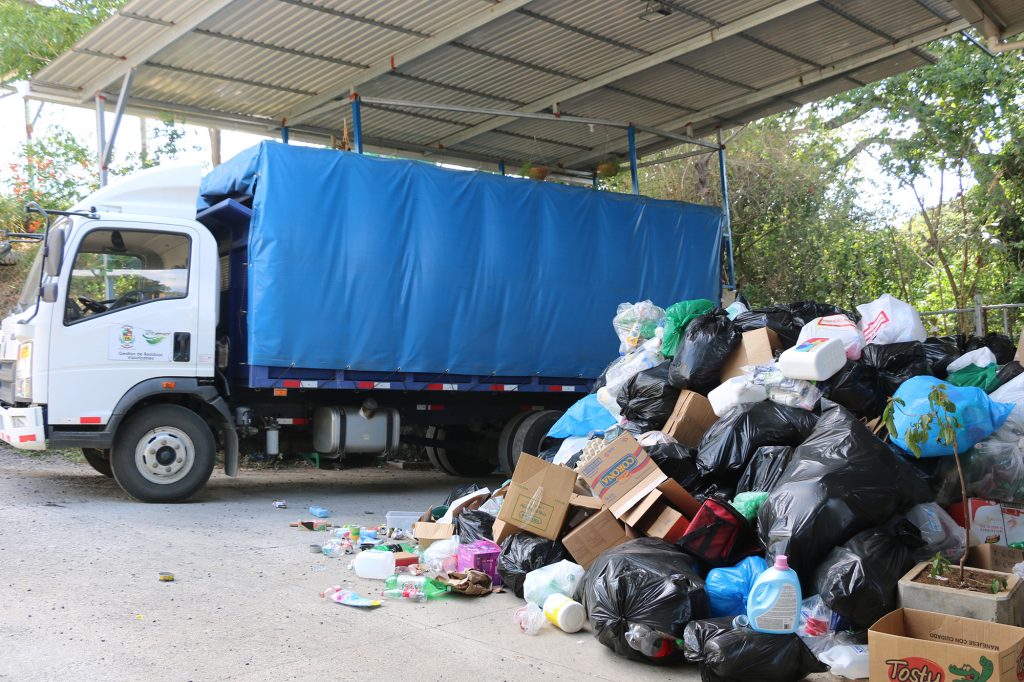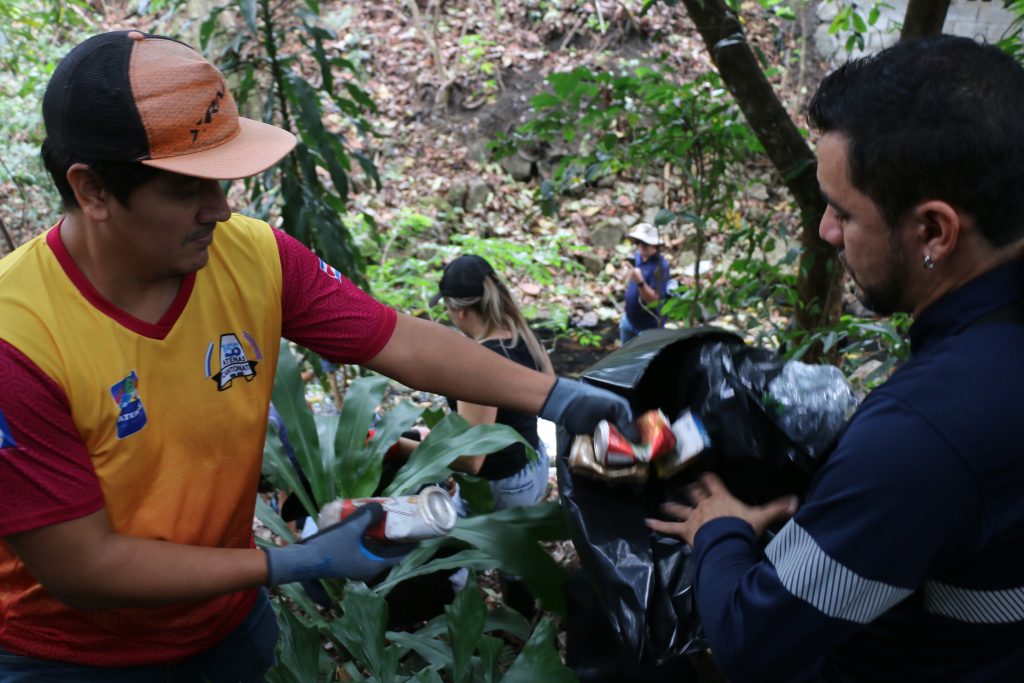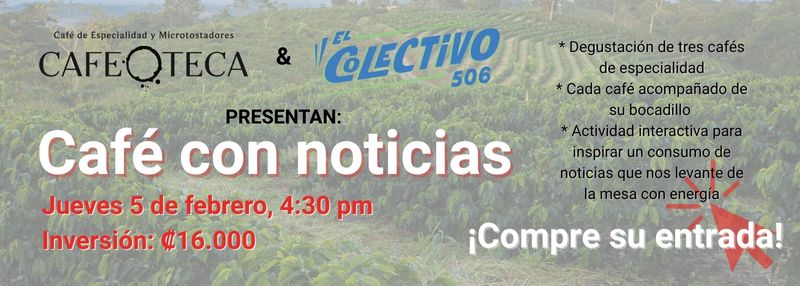The canton of Atenas is known as the home of “the best climate in the world”—thanks to a 1968 article in National Geographic—and as a diverse and modern community that attracts both Costa Rican and foreign retirees. However, less than a decade ago, its solid waste problems were a stain on that reputation. Garbage was collected by a tractor-pulled cart; coffee growers dumped their byproducts straight into the rivers; and if homeowners lived outside of the municipality’s limited collection area, but had a large enough patio, they just set fire to their trash.
This stood in sharp contrast to our neighbors in the canton of Grecia, a standard-bearer for waste management. In fact, Grecia was declared “The cleanest city in Latin America” in 1989. This distinction was awarded during a meeting of the Latin American chapter of the International Union of Municipalities and Powers, in Cuenca, Ecuador, with the participation of every country in Latin America.
Atenas was left behind. However, this began to change in 2018. That’s when the Municipality of Atenas began to develop a matrix of environmental projects, starting from the management of solid waste, through the creation of the Environmental Management Unit.
Located in the province of Alajuela, 40 km from San José, this municipality finally began taking waste collection seriously, expanding its work in a comprehensive way. “Atenas Ciudad Limpia” (“Atenas, Clean City”) has deployed a series of specific actions in the collection of recoverable waste, ordinary waste, non-traditional waste, and special-handling waste such as tires.
By buying collection equipment, building a collection center, and improving the selection of recoverable materials, the community has transformed residents’ perspective on solid waste management. Most recently, the program started collecting electrical waste and electronic equipment, thus completing the sphere of comprehensive waste management for the canton’s 30,000 residents.
But how was this achieved? And what has been learned that could be applied to the many areas of Costa Rica that still do not offer these services to their populations?

Collection, partial; recycling, zero
Five years ago, solid waste collection was offered out only in the city center and some surrounding neighborhoods. The rest of the population had to deal with their trash on their own. That’s why tractor pickup, dumping in the river, and burning garbage were so common around the canton.
In the area that did have pickup, all the garbage that was collected was taken to an open-air dump located less than two kilometers from the city center. This dump generated pollution for the surrounding communities, especially when garbage was burned. The area saw increasing numbers of vultures, nasty smells, and “divers” (people who search for useful items in the trash, despite the threats to their health). There was no municipal recycling option to reduce the flow of waste to that landfill—or to rivers, fires, and other destinations in the rest of the canton.
Some progress took place because of unrelated changes. One of these was the opening of the Atenas Radial when Route 27 was inaugurated in 2010. The new highway crossed exactly through the former open-air dump, leaving Atenas without a place for its trash.
This eliminated a source of pollution for the surrounding communities, and forced the municipality to begin moving all its waste out of the canton. Today, Atenas must transfer the 593.45 metric tons of waste it produces each month the Los Mangos landfill in Alajuela or to Miramar in Puntarenas.
Meanwhile, an appeal for protection before the Constitutional Chamber of the Supreme Court (Sala IV) by the Santa Eulalia Development Association forced the municipality to extend trash collection services to the entire canton in 2019. This process has been gradual.
However, the most important change began in 2018, when the Municipality created an Environmental Management Unit for the first time. This was the start of a more comprehensive approach, beginning with new partnerships that could contribute ideas and resources for recycling.

New leaders, new alliances
The Municipality, in its 2021-2025 Strategic Plan, agreed to “consolidate a recovered, resilient, and sustainable urban ecosystem, free of environmental tensions due to bad human practices, and with institutional and social capacities to protect the population’s right to a healthy environment.”
The plan motivated the municipality to start working with new partners. Alliances were forged with the Atenas Lyceum and its International Baccalaureate program; the Center for Studies for Sustainable Development in Los Angeles, known locally as the Universidad de la Presa, which receives a significant number of North American students; and the community development associations, or ADI. The municipality also worked with the Administrative Associations of Communal Aqueduct and Sewer Systems (ASADAS).
Furthermore, two young Athenians assumed leadership roles: Jeudy Ortiz, head of the Environmental Management Unit of the Municipality of Atenas, and Jonathan Chaves Quesada, member of the Environmental Commission of Altos de Naranjo, San Isidro de Atenas (CAANSIA).
The National Emergency Commission was another important player. More than a decade ago, the CNE urged the municipal council to develop programs in favor of the environment. According to the section of the municipality’s website dedicated to the Municipal Emergency Committee, the CNE requested, among other things, that the municipality “promote environmental education and land use programs for construction purposes to avoid contamination of rivers and streams with solid waste, as well as to establish neighborhood brigades for the cleaning and maintenance of drains and water channels.”
As the project developed, other partners from outside the canton got involved. One example is the Embassy of Israel, which donated collection containers for glass and plastic containers, placed in strategic places in the canton.

So what was achieved?
According to Jeudy Ortiz, the Environmental Management Unit has established weekly collection routes in most communities, and bought equipment for both solid waste collection, and non-traditional and recoverable waste collection tasks.
Over the past year, the municipality invested approximately ¢300 million colones (about $588,000) of its own resources to buy six new vehicles that aid with collection in narrow streets.
Today’s Atenas waste management project has a modern fleet and is analyzing the possibility of acquiring a new collector, because those that are in service have reached the end of their useful life. The municipality does not have the resources for this, and is considering using its credit.
Recyclable waste is taken to a municipal recovery center next to the Municipal Stadium. The municipality provides all the funding and equipment for the operation of the center. For human resources, the municipality has an agreement with the San Isidro Comprehensive Development Association: through this, women from the community staff the center.
Thanks to all of this, Atenas now has a schedule for the collection of recycling material, non-traditional waste, and electronic waste.
Students from educational centers, volunteers, the Municipal Emergency Committee and local companies have joined in the electronic waste collection days, or RAEE-TON.
According to Jonathan Salguero, who teaches International Baccalaureate students at the Liceo de Atenas, the young people who take part in the RAEE-TON do prior research on the effects and repercussions that technology has both on the environment and on the health of people and animals. The idea is not to stop just at waste collection but to go further, knowing how the materials decompose. He says that it’s useful for them to understand their impact on the environment, thereby creating environmental awareness that will serve them well in the future.
By the numbers
According to Jeudy, Atenas has increased waste recovery by 4.7% over the life of the program. The canton generates 593.45 tons and averages 46 tons in recycling—close to 8%.
In addition, 70% of the population has begun separating and classifying recoverable waste. What about the other 30%? Jeudy says that they may be in transition, have not received complete information, or lack awareness about the separation and classification of waste. The goal now is to make sure that environmental education in schools helps address this.
However, a significant sector of the population is well informed about recycling, which has reduced the number of clandestine dumps. In the latest report from the mayor to the Municipal Council, 194 of these sites have been eliminated; 21 non-traditional waste campaigns have recovered 221.7 tons; and in 2024, RAEE-TON will take place three times instead of once yearly.
New efforts now underway include an initiative to reduce curbside trash dumping, to expand the collection of non-traditional waste, and to better manage oils, electronic waste, and tires. This last effort is carried out in conjunction with the Ministry of Health, given the high incidence of dengue cases in the area.
The case of San Isidro
In 2019, the municipal truck did not pass through Altos de Naranjo, the main community in the San Isidro district. The problem of garbage in rivers, coffee plantations, and vacant lots was very common. Today, however, this district is an example of how improvements in waste management can lead to other initiatives for the environment, beyond the issue of garbage.
Community pressure managed to get the municipal garbage truck to collect solid waste. For recycling, the ASADA set up a makeshift collection center for recoverable materials. The people of San Isidro took their recyclables there for six months until the municipality developed other recycling options.
These shared activities between neighbors, and the synergy with alliances that were being created in other parts of the canton, triggered more impact. Jonathan, the leader of CAANSIA, is also part of the Comprehensive Development Association and the ASADA of Altos de Naranjo. He explains that with the support of the Universidad de la Presa, these entities identified a surprisingly high number of animals that live in the sites surrounding the water sources in San Isidro, an important factor to take into account in environmental protection efforts. These groups have been working on environmental issues since 2019. This year, they have proposed an initiative called “Friendly Asadas” to work together with groups that have common interests.
They began reforestation campaigns on the land of two ASADAS, with trees donated by the Ministry of Agriculture and Livestock (MAG). They realized that the tree species were not suitable for certain areas, so they began to investigate trees that had climatic characteristics suitable for the height of this territory. From there, they began to germinate and plant native and endangered tree species at the ASADAS, such as sota gallina, guapinol, espavel, chirraca, mahogany, lorito, tucuico, and higuerones.
The National Technical University (UTN) has joined in with environmental management students. Their projects with the ASADAS focus on students getting involved and learning about environmental education.

Challenges: what will it take to sustain this?
What are the limitations that this initiative faces?
The first key to its survival is sustainable financial resources over time. That’s what’s needed to guarantee the sustainability of the recoverable waste collection system. Furthermore, a socio-environmental promoter is required at all times to be the leading voice from inside the municipality. And sustaining the program requires a lot of political will, which Atenas has had during this process—but which is not guaranteed.
If these factors can be maintained, the program will need to figure out how to raise awareness among that 30% of the population that still resists separating waste. To achieve this, the program has intensified its public spaces and river cleanup campaigns, carried out non-traditional waste collection campaigns, and continuously shared information about recycling at area fairs and festivals
Another challenge is achieving job stability for the people who work at the municipal recycling center. The project works through an agreement with the San Isidro Development Association, led by women hired by the Association. At certain times of the year, such as Christmas, when the flow of materials to the center increases, the center resorts to temporary workers who are paid with the income from the sale of valuable materials. When the project is consolidated, these personnel could be integrated into the municipal payroll.
Atenas has just welcomed in a new municipal government. On May 1, Máximo Chaves Ovares of the Social Democratic Progress Party, the outgoing Council, assumed his duties as the new municipal mayor, replacing Wilberth Aguilar Gatjens, of the Christian Social Unity Party. Jeudy says that for his part, the focus of work will be the same, with some small adjustments to meet the interest of the new municipal authorities. The inclusion of this line of work in the Municipality’s 2021-2025 Strategic Plan will also provide it with some stability in local policies.
In a meeting where we asked the future mayor about this issue, he promised to support the work of his officials in the environmental area and of the young people who, from civil society, have developed a positive conscience in favor of the environment.
“We are not going to touch what is good,” said the future mayor. “But we will make adjustments where necessary.”





